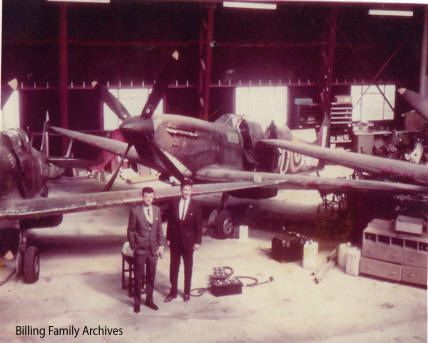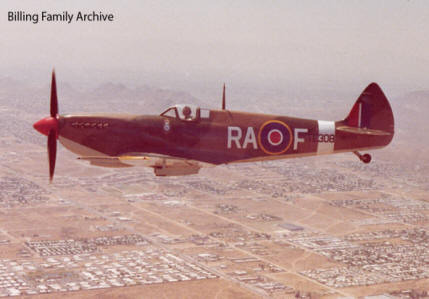History of Spitfire TR9. TE308
 TE308 was built on April 19th, 1944 as a single seat "low back" Mk
IXe at the Castle Bromwich Aircraft Factory in Castle Bromwich, United
Kingdom (U.K.) and delivered to #39 MU (Maintenance Unit) RAF (Royal Air
Force) Colerne on June 9th, 1945. It is interesting to note that all
Spitfires were built as single seat originally, including this one.
TE308 finished out the end of the World War Two as a single seat model
Mk IXe never seeing combat in RAF storage. It then stayed in storage for
the next five years until January of 1950. It was then sent to #29
Maintenance Unit High Ercall Shropshire. After being sent to #29 MU it
was then sold to Vickers-Armstrong's Ltd as non-effective on
July 19, 1950.
TE308 was built on April 19th, 1944 as a single seat "low back" Mk
IXe at the Castle Bromwich Aircraft Factory in Castle Bromwich, United
Kingdom (U.K.) and delivered to #39 MU (Maintenance Unit) RAF (Royal Air
Force) Colerne on June 9th, 1945. It is interesting to note that all
Spitfires were built as single seat originally, including this one.
TE308 finished out the end of the World War Two as a single seat model
Mk IXe never seeing combat in RAF storage. It then stayed in storage for
the next five years until January of 1950. It was then sent to #29
Maintenance Unit High Ercall Shropshire. After being sent to #29 MU it
was then sold to Vickers-Armstrong's Ltd as non-effective on
July 19, 1950.
THE CONVERSION TO TYPE 509 (TWO SEATS)
 After the end of the World War Two on September 1945, there wasn't a
demand for Spitfires. Vickers-Armstrongs (Aircraft) Ltd still had many
trained employees and production facilities after the war. The world was
moving to the Jet age and new avenues were always being explored for the
continued use of their aircraft. As a result of looking for new uses, a
program of converting a number of existing Spitfires into two cockpit
armed trainer versions for sale to foreign governments around the world.
Plans called for nine to be built for Holland, ten for India, and one
for Egypt. There are rumors that TE308 was the aircraft converted for
Egypt, but the sale fell through. This is difficult to prove as only a
few pictures of the aircraft exist at this time, and none clearly show
the Egyptian identification. The conversion plans called for the front
cockpit to be moved forward 13 1/2 inches. Rear seat instruments were
fitted and the back seat was provided with a large bubble canopy. Only
part of the wing guns were retained and fuel space was added in the
wings to replace one lower fuselage tank that was removed. The student
was to fly in the front cockpit while the instructor supervised in the
rear one. In total, 20 Spitfires were converted from the single seat to
the two-seat trainer.
After the end of the World War Two on September 1945, there wasn't a
demand for Spitfires. Vickers-Armstrongs (Aircraft) Ltd still had many
trained employees and production facilities after the war. The world was
moving to the Jet age and new avenues were always being explored for the
continued use of their aircraft. As a result of looking for new uses, a
program of converting a number of existing Spitfires into two cockpit
armed trainer versions for sale to foreign governments around the world.
Plans called for nine to be built for Holland, ten for India, and one
for Egypt. There are rumors that TE308 was the aircraft converted for
Egypt, but the sale fell through. This is difficult to prove as only a
few pictures of the aircraft exist at this time, and none clearly show
the Egyptian identification. The conversion plans called for the front
cockpit to be moved forward 13 1/2 inches. Rear seat instruments were
fitted and the back seat was provided with a large bubble canopy. Only
part of the wing guns were retained and fuel space was added in the
wings to replace one lower fuselage tank that was removed. The student
was to fly in the front cockpit while the instructor supervised in the
rear one. In total, 20 Spitfires were converted from the single seat to
the two-seat trainer.
LIFE IN THE IRISH AIR CORPS

Once the TE308 was converted to the Type 509 configuration at a
Southampton factory, she was sent to the Irish Air Corps (IAC) with five
others on July 10, 1951. Delivered on July 30th, she was already painted
the standard "Irish" green, and took the number IAC 163. Flying a
variety of missions, sometimes carrying bomb racks, TE308 only suffered
one forced landing during this time. Retired in the fall of 1961, she
continued to be flown by the IAC for instructional use and ground
running practice. On March 4, 1968 she was decommissioned and sold to
collector Tony Samuelson and Spitfire Productions Ltd.. Tony purchased a
total of five Spitfires and one Hurricane. This, according to some,
would make Tony owner of the worlds seventy-eighth largest air force. On
April 4, 1968 the TE308 was officially registered as G-AWGB and flown
from Ireland to the UK on May 8, 1968.
BATTLE OF BRITAIN MOVIE
Tony Samuelson owned four trainer aircraft purchased from the
IAC, of which two were used for the Battle of Britain movie. First
completing an overhaul on May 27, 1968 she was delivered to the filming
location in Debden. TE308 flew with the camera located in the front
cockpit. The forward looking "Spitfire" images in the movie were filmed
by the TE308. The other Tr. 9, called MJ722 didn't fair as well after a
belly landing brought about by an engine fire early on in filming. As
the filming continued, several different "codes" were applied to the
side of the aircraft to vary the appearance.
 Producers selected several
codes that were never actually used during wartime service. There were
some worries that people would be offended by code letters on the side.
By changing the letters, it prevented the complaint that this or that
squadron never took part in an event. When filming of the Battle of
Britain was completed, the aircraft was stored at the Samuelson Film
Services hangar at Elstree around November 1968 and there it sat.
Everyone would ask the current owner, "When are you going to go solo in
your Spitfire and Hurricane?" After soloing once in MJ722, Tony
Samuelson soon came to realize that this hobby may soon end. With the
70's oil crisis and the stock market crash, he had to put his private
‘Air Force' Spitfires, Hurricane and helicopter up for sale. For over a
year the Spitfires remained up for sale, posted in for sale section of
Flight magazine. Finally, in April of 1970, Tony Samuelson sold his four
Tr.9 Spitfires to Sir William J D Roberts.
Producers selected several
codes that were never actually used during wartime service. There were
some worries that people would be offended by code letters on the side.
By changing the letters, it prevented the complaint that this or that
squadron never took part in an event. When filming of the Battle of
Britain was completed, the aircraft was stored at the Samuelson Film
Services hangar at Elstree around November 1968 and there it sat.
Everyone would ask the current owner, "When are you going to go solo in
your Spitfire and Hurricane?" After soloing once in MJ722, Tony
Samuelson soon came to realize that this hobby may soon end. With the
70's oil crisis and the stock market crash, he had to put his private
‘Air Force' Spitfires, Hurricane and helicopter up for sale. For over a
year the Spitfires remained up for sale, posted in for sale section of
Flight magazine. Finally, in April of 1970, Tony Samuelson sold his four
Tr.9 Spitfires to Sir William J D Roberts.

Still carrying the British Civil code G-AWGB, the TE308 was stored briefly with the "Strathallan Collection" in the aircraft museum in Scotland. On July 16th, 1970 Sir William sold the aircraft to a Canadian businessman, Donald J. Plumb (Don). With the help of Jerry Billing and his connections in the RAF and RCAF Don had TE308 shipped on September 11th, 1970 and arrived in Toronto, Ontario on October 9th, 1970. Don Plumb had the aircraft refurbished and registered as CF-RAF. At the time, it was Canada's only licensed and flying Spitfire. Don and partner Jerry ( Plumb Managements ) displayed TE308 across North America.

TE308 was converted to a single control Spitfire in 1972 by removing the rear canopy and paneling over the rear location. Once covered over, the aircraft was given the livery of RA-F and from then on flew as TE308. The registration was changed to C-FRAF, and that was carried until Don Plumb was killed in his P51-D in 1975. The aircraft was then sold by Don Plumb's widow to Thomas Watson Jr. in October of 1976. The aircraft was ferried by Jerry Billing to its new home in Maine. The trip to Maine was not without its own adventures, as Jerry Billing landed her at night in a snowstorm with no lights or cockpit lighting. The tower had given him clearance to land, but he was already down. Mr. Watson received the aircraft in Maine and re-registered it as N92477. It was maintained at the Owl's Head Transportation Museum until the late part of 1979 being flown only occasionally.

In 1983, the aircraft was purchased by Bill Greenwood of Aspen, Colorado. Jerry Billing provided a demonstration flight to Bill in Carefree Arizona around the time of purchase. There were a few things missing when Bill bought it. One was the rollover support behind the rear seat. That was remade around 1998 at QG Aviation of Ft. Collins and fashioned to be just like the original. The back canopy was already there, but a few back seat items needed to be fixed up. Painted RJ-M after the Spitfire designer R.J. Mitchell, Bill Greenwood regularly flies in the Colorado area.
This History was researched and written by Paul Gordon